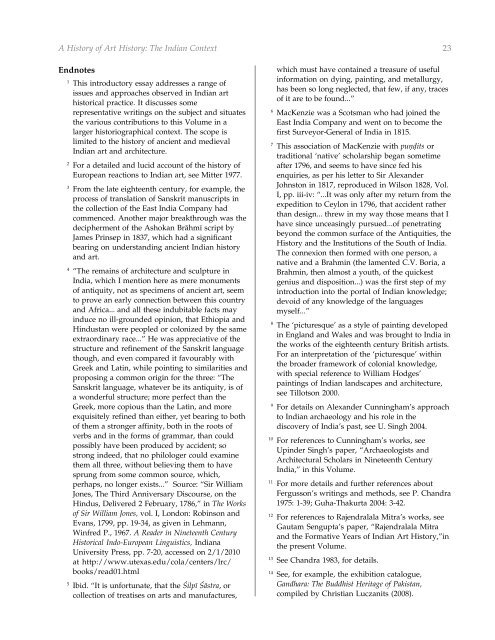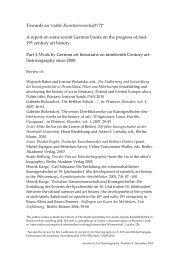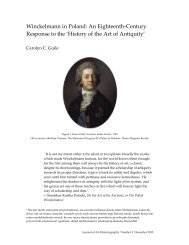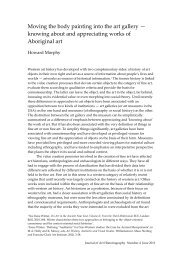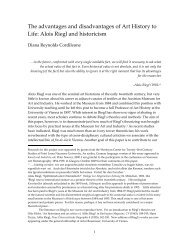Indian Art history.cdr - Journal of Art Historiography
Indian Art history.cdr - Journal of Art Historiography
Indian Art history.cdr - Journal of Art Historiography
You also want an ePaper? Increase the reach of your titles
YUMPU automatically turns print PDFs into web optimized ePapers that Google loves.
A History <strong>of</strong> <strong>Art</strong> History: The <strong>Indian</strong> Context 23<br />
Endnotes<br />
1 This introductory essay addresses a range <strong>of</strong><br />
issues and approaches observed in <strong>Indian</strong> art<br />
historical practice. It discusses some<br />
representative writings on the subject and situates<br />
the various contributions to this Volume in a<br />
larger historiographical context. The scope is<br />
limited to the <strong>history</strong> <strong>of</strong> ancient and medieval<br />
<strong>Indian</strong> art and architecture.<br />
2 For a detailed and lucid account <strong>of</strong> the <strong>history</strong> <strong>of</strong><br />
European reactions to <strong>Indian</strong> art, see Mitter 1977.<br />
3 From the late eighteenth century, for example, the<br />
process <strong>of</strong> translation <strong>of</strong> Sanskrit manuscripts in<br />
the collection <strong>of</strong> the East India Company had<br />
commenced. Another major breakthrough was the<br />
decipherment <strong>of</strong> the Ashokan Brähmé script by<br />
James Prinsep in 1837, which had a significant<br />
bearing on understanding ancient <strong>Indian</strong> <strong>history</strong><br />
and art.<br />
4 “The remains <strong>of</strong> architecture and sculpture in<br />
India, which I mention here as mere monuments<br />
<strong>of</strong> antiquity, not as specimens <strong>of</strong> ancient art, seem<br />
to prove an early connection between this country<br />
and Africa... and all these indubitable facts may<br />
induce no ill-grounded opinion, that Ethiopia and<br />
Hindustan were peopled or colonized by the same<br />
extraordinary race...” He was appreciative <strong>of</strong> the<br />
structure and refinement <strong>of</strong> the Sanskrit language<br />
though, and even compared it favourably with<br />
Greek and Latin, while pointing to similarities and<br />
proposing a common origin for the three: “The<br />
Sanskrit language, whatever be its antiquity, is <strong>of</strong><br />
a wonderful structure; more perfect than the<br />
Greek, more copious than the Latin, and more<br />
exquisitely refined than either, yet bearing to both<br />
<strong>of</strong> them a stronger affinity, both in the roots <strong>of</strong><br />
verbs and in the forms <strong>of</strong> grammar, than could<br />
possibly have been produced by accident; so<br />
strong indeed, that no philologer could examine<br />
them all three, without believing them to have<br />
sprung from some common source, which,<br />
perhaps, no longer exists...” Source: “Sir William<br />
Jones, The Third Anniversary Discourse, on the<br />
Hindus, Delivered 2 February, 1786,” in The Works<br />
<strong>of</strong> Sir William Jones, vol. I, London: Robinson and<br />
Evans, 1799, pp. 19-34, as given in Lehmann,<br />
Winfred P., 1967. A Reader in Nineteenth Century<br />
Historical Indo-European Linguistics, <strong>Indian</strong>a<br />
University Press, pp. 7-20, accessed on 2/1/2010<br />
at http://www.utexas.edu/cola/centers/lrc/<br />
books/read01.html<br />
5 Ibid. “It is unfortunate, that the Çilpé Çästra, or<br />
collection <strong>of</strong> treatises on arts and manufactures,<br />
which must have contained a treasure <strong>of</strong> useful<br />
information on dying, painting, and metallurgy,<br />
has been so long neglected, that few, if any, traces<br />
<strong>of</strong> it are to be found...”<br />
6 MacKenzie was a Scotsman who had joined the<br />
East India Company and went on to become the<br />
first Surveyor-General <strong>of</strong> India in 1815.<br />
7 This association <strong>of</strong> MacKenzie with puëòits or<br />
traditional ‘native’ scholarship began sometime<br />
after 1796, and seems to have since fed his<br />
enquiries, as per his letter to Sir Alexander<br />
Johnston in 1817, reproduced in Wilson 1828, Vol.<br />
I, pp. iii-iv: “...It was only after my return from the<br />
expedition to Ceylon in 1796, that accident rather<br />
than design... threw in my way those means that I<br />
have since unceasingly pursued...<strong>of</strong> penetrating<br />
beyond the common surface <strong>of</strong> the Antiquities, the<br />
History and the Institutions <strong>of</strong> the South <strong>of</strong> India.<br />
The connexion then formed with one person, a<br />
native and a Brahmin (the lamented C.V. Boria, a<br />
Brahmin, then almost a youth, <strong>of</strong> the quickest<br />
genius and disposition...) was the first step <strong>of</strong> my<br />
introduction into the portal <strong>of</strong> <strong>Indian</strong> knowledge;<br />
devoid <strong>of</strong> any knowledge <strong>of</strong> the languages<br />
myself...”<br />
8 The ‘picturesque’ as a style <strong>of</strong> painting developed<br />
in England and Wales and was brought to India in<br />
the works <strong>of</strong> the eighteenth century British artists.<br />
For an interpretation <strong>of</strong> the ‘picturesque’ within<br />
the broader framework <strong>of</strong> colonial knowledge,<br />
with special reference to William Hodges’<br />
paintings <strong>of</strong> <strong>Indian</strong> landscapes and architecture,<br />
see Tillotson 2000.<br />
9 For details on Alexander Cunningham’s approach<br />
to <strong>Indian</strong> archaeology and his role in the<br />
discovery <strong>of</strong> India’s past, see U. Singh 2004.<br />
10 For references to Cunningham’s works, see<br />
Upinder Singh’s paper, “Archaeologists and<br />
Architectural Scholars in Nineteenth Century<br />
India,” in this Volume.<br />
11 For more details and further references about<br />
Fergusson’s writings and methods, see P. Chandra<br />
1975: 1-39; Guha-Thakurta 2004: 3-42.<br />
12 For references to Rajendralala Mitra’s works, see<br />
Gautam Sengupta’s paper, “Rajendralala Mitra<br />
and the Formative Years <strong>of</strong> <strong>Indian</strong> <strong>Art</strong> History,”in<br />
the present Volume.<br />
13 See Chandra 1983, for details.<br />
14 See, for example, the exhibition catalogue,<br />
Gandhara: The Buddhist Heritage <strong>of</strong> Pakistan,<br />
compiled by Christian Luczanits (2008).


